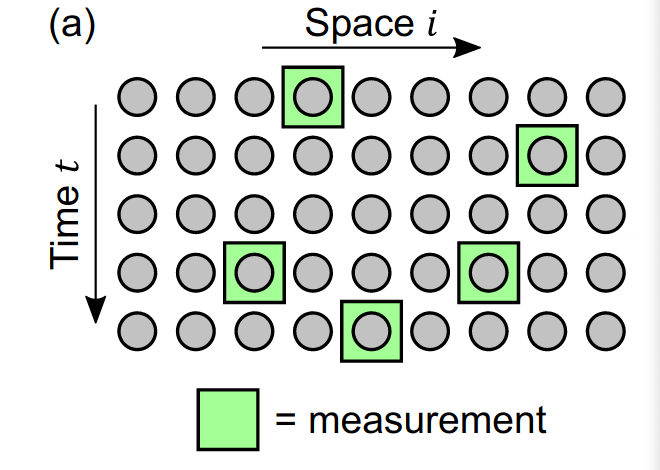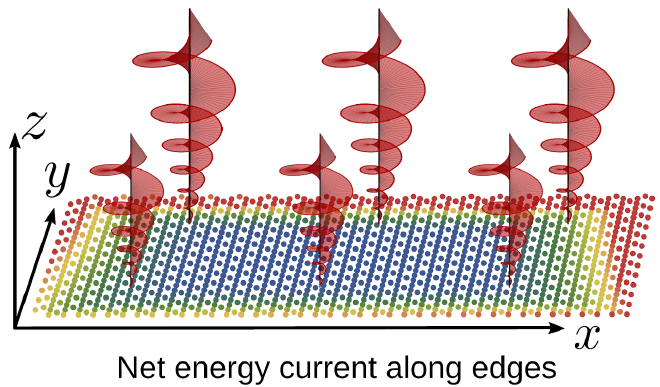Many-body physics
Table of Contents
Computational complexity #
If a state has a low circuit complexity, it is also easy to classically simulate it. Conversely, if a computationally hard problem can be embedded into a state, then it cannot be too easy to prepare it. Complexity is an important notion for variational ansatz states, because if the complexity of a variational family is too low, we cannot use the family to solve hard problems. On the other hand, if it’s too high, we cannot use the family full stop.
Isometry tensor network states, introduced in (Zaletel and Pollmann, 2020) seem to inhabit a sweet spot: they can capture many states, so they aren’t trivial, but they also not too hard. But how hard are they exactly? This is what we set out to answer in Ref. [5].
We use what we have learned about sequential circuits to assess the computational complexity of isometric tensor network states (isoTNS) [2]. The key twist in this work is that properties (say, local expectation values) of 2D isoTNS can be mapped to an equivalent (1+1)D open quantum circuit, which lets us map the complexity of local expectation values to simulating quantum circuits with depolarizing noise, and sampling complexity to measurement-induced phase transitions.
- Computational complexity of isometric tensor network states
Malz, Trivedi, arXiv
Information spreading in many-body systems #
The spreading of entanglement has been a major research theme in the many-body physics community for several years now. Most recently, a lot of attention has been devoted to the entanglement phase transition that occurs in monitored quantum circuits.
We were wondering how fundamentally “quantum” this phenomenology is. To our surprise, we numerically found that one can define classical models that exihibt very similar behaviour [1]. Recently, we made this connection much stronger by introducing and studying models of random reversible classical circuits, for which it is possible to compute certain quantities such as Renyi-2 entanglement growth or out-of-time ordered correlators analytically [2]. Remarkably, we discovered exact mathematical equalities between quantities defined classically (like damage spreading or growth of entropy) to equivalent quantum quantities (OTOCs and also growth of entropy).

- Bridging the gap between classical and quantum many-body information dynamics
Pizzi, Malz, Nunnenkamp, Knolle, PRB (2022), arXiv - Quantum and Classical Dynamics with Random Permutation Circuits
Bertini, Klobas, Kos, Malz, arXiv (2024)
Discrete time crystals #
Time crystals are nonequilibrium phases of matter that spontaneously break time-translation symmetry. The classic example here is one of a spin chain with a π-pulse applied every period. Two π-pulses are equivalent to the identity, which means the systems recurs only after two periods [a].
In a generic closed system, one would expect the drive to heat up the system to a infinite temperature state, which is why it is understood that one needs to add MBL to stabilize the phase [a]. Yet, even in the absence of MBL gives a subharmonic response for time scales that are exponentially long in systems sizes, which would suggest time-crystalline order in the absence of MBL. In a numerical analysis, we have shown that a previously overlooked, subtle effect can explain why the apparent subharmonic response scaling is misleading, thus further clarifying the role of MBL in such systems [3].
In classical systems, it is less clear how time crystalline phases can arise, as also the “rules” are less clear. Previous work has suggested that in one-dimensional systems, short-range interactions are not sufficient [b], but long-range interactions may indeed stabilize DTC order [c]. In our work we take ask more questions about this classical setting, by studying the example of seasonal epidemic spreading on small-world graphs, and identify a setup where an arbitrarily small density of random (infinite-range) bonds is sufficient for a transition to a time-crystalline phase [4]. In contrast to previous models, our model includes non-Markovianity in the form of “immune sites” that are non-dynamical for a set period of time. This opens an interesting parallel between research on DTCs and models that have been in use for decades in epidemiology.

- Time crystallinity and finite-size effects in clean Floquet systems
Pizzi, Malz, Nunnenkamp, Knolle, PRB (2020), arXiv. - Seasonal epidemic spreading on small-world networks: Biennial outbreaks and classical discrete time crystals
Malz, Pizzi, Nunnenkamp, Knolle, PRR (2021), arXiv
Topological magnon amplification #
This project concerns the amplification of magnons in chiral topological edge modes [5]. Such modes arise in certain (3D, but effectively 2D) magnetic insulators with Dzyaloshinskii-Moriya interaction, most notably with kagome [e] and honeycomb [f] lattices. We show that driving such systems with light can lead to edge mode instabilities and nonequilibrium steady states with large edge magnon population and further show that driving with a gradient leads to some sort of driven magnon Hall effect, two aspects that will aid their direct experimental detection. Beyond the characterisation these materials, our magnon amplification mechanism can be used to build a coherent magnon source (a magnon laser) and a travelling-wave magnon amplifier, two devices with great potential in the realm of magnon spintronics.

- Topological magnon amplification
Malz, Knolle, Nunnenkamp, ncomms (2019), arXiv